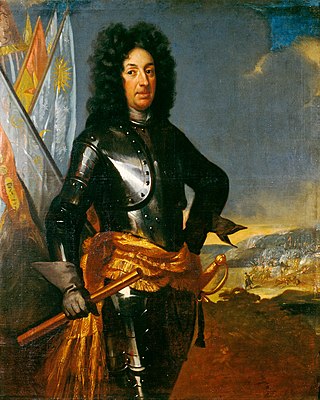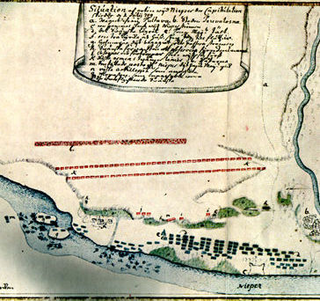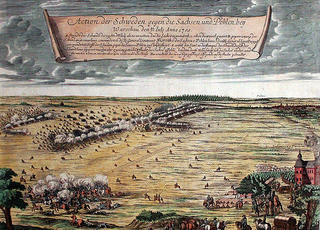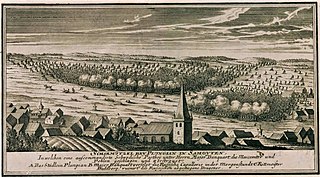
The Battle of Lesnaya was one of the major battles of the Great Northern War. It took place on October 9 [O.S. September 28] 1708 between a Russian army of between 26,500 and 29,000 men commanded by Peter I of Russia, Mikhail Mikhailovich Golitsyn, Aleksandr Danilovich Menshikov, Christian Felix Bauer and Nikolai Grigorovitj von Werden and a Swedish army of about 12,500 men commanded by Adam Ludwig Lewenhaupt and Berndt Otto Stackelberg, at the village of Lesnaya, located close to the border between the Polish–Lithuanian Commonwealth and Russia. The Swedes were escorting a supply column of more than 4,500 wagons for their main army in Ukraine.

The Battle of Poltava was the decisive and largest battle of the Great Northern War. A Russian army under the command of Tsar Peter I defeated a Swedish army, under the command of Carl Gustaf Rehnskiöld. The battle put an end to the status of the Swedish Empire as a European great power, as well as its eastbound expansion, and marked the beginning of Russian influence in Northern Europe.

The Battle of Fraustadt was fought on 2 February 1706 (O.S.) / 3 February 1706 / 13 February 1706 (N.S.) between Sweden and Saxony-Poland and their Russian allies near Fraustadt in Poland. During the Battle of Fraustadt on February 3, August II was only 120 km away, with a cavalry force about 8,000 men strong. According to Cathal Nolan that caused Swedish General Rehnskiöld to rush to engage Schulenburg. The Swedes were outnumbered by more than two to one by Saxons, mercenaries, and Russians. Ignoring the odds, Rehnsköld attacked the enemy's well-entrenched position. He sent cavalry to drive off defending Saxon horse on either wing and complete a classic double envelopment. The manoeuvre meant they could attack from behind into the center rear of the enemy's main line. The result was 8,000 Russian deaths and 5,000 Saxons and German mercenaries taken prisoner. The battle is a textbook example of a perfect pincer movement and was one of Sweden's key victories in the Great Northern War.

Caroleans, from Carolus, the Latin form of the name Charles, is a term used to describe soldiers of the Swedish army during the reigns of Kings Charles XI and Charles XII of Sweden, and specifically from 1680, when Charles XI instituted an absolute monarchy and embarked on a series of sweeping military reforms, to the death of Charles XII in 1718.

The Battle of Holowczyn or Holofzin or Golovchin was fought in July 1708 between the Russian army, and the Swedish army, led by Charles XII of Sweden, only 26 years of age at the time. Despite difficult natural obstacles and superior enemy artillery, the Swedes were able to achieve surprise and defeat the numerically superior Russian forces, who were separated from each other, had no overall command and could not coordinate their actions, so that only 8,000-9,000 of them could take part in the fighting. From the Swedish side, less 2,500 soldiers, led by King Charles XII, took part in the battle. Reportedly, it was Charles' favourite victory.

Adam Ludwig Lewenhaupt was a Swedish general, particularly known for his participation in the Great Northern War.

Count Carl Gustav Rehnskiöld was a Swedish Field Marshal (fältmarskalk) and Royal Councillor. He was mentor and chief military advisor to King Charles XII of Sweden, and served as deputy commander-in-chief of the Carolean Army, an army he assisted both in its education and development.

The Battle of Gemauerthof was a battle in the Great Northern War, fought south of Riga near Jelgava, in present-day Latvia in July 1705. The Swedish forces under Adam Ludwig Lewenhaupt fought a Russian army under Boris Sheremetyev. The Swedes were victorious, but the victory was only symbolic. In August, the Russians conquered Courland.

The invasion of Russia by Charles XII of Sweden was a campaign undertaken during the Great Northern War between Sweden and the allied states of Russia, Poland, and Denmark. The invasion began with Charles's crossing of the Vistula on 1 January 1708, and effectively ended with the Swedish defeat in the Battle of Poltava on 8 July 1709, though Charles continued to pose a military threat to Russia for several years while under the protection of the Ottoman Turks.

The Battle of Jakobstadt was a battle fought in the Great Northern War. It took place on 25 July 1704 (O.S.) / 26 July 1704 / 5 August 1704 (N.S.) between a Swedish army under Adam Ludwig Lewenhaupt and a combined Polish/Russian force under Great Hetman Michał Serwacy Wiśniowiecki at the town of Jēkabpils in the Duchy of Courland and Semigallia. The Swedes were victorious.

The Battle of Molyatichi, also known as the Battle of Dobroye, took place on August 31, 1708 at Molyatichi during the Great Northern War. The Russian army of Peter the Great under the command of Mikhail Golitsyn successfully attacked the avantgarde of the Swedish Army of Charles XII under Carl Gustaf Roos. The fighting occurred in the swamp between the rivers Belaya Natopa and Chernaya Natopa. The Swedish force under Roos was surprised by the Russian attack in the morning fog and steadily withdrew towards the main Swedish army. The swampy landscape prevented the Russian cavalry to cut off the Swedish way of retreat. As Swedish reinforcements arrived, the Russians were put on the defensive. Since the attack of the main body of the Swedish army was not part of the Russian intentions at that moment, and to avoid a disastrous defeat, the Russians withdrew. According to the Russian description, this was done in order, while the Swedish one claims their retreat turned into a disorganized flight as the Swedes pursued. Many Russians were killed in the swamps.

The surrender at Perevolochna was the capitulation of almost the entire Swedish army on 30 June 1709 (O.S.) / 1 July 1709 / 11 July 1709 (N.S.). It signified the annihilation of the once formidable Swedish army after the defeat at Battle of Poltava, and paved the way for the eventual Russian victory in the Great Northern War. After the Battle of Poltava, Charles XII escaped to Moldavia, a vassal state of the Ottoman Empire.

The Battle of Warsaw was fought on 31 July 1705 near Warsaw, Poland, during the Great Northern War. The battle was part of a power struggle for the Polish–Lithuanian throne. It was fought between Augustus II the Strong and Stanisław Leszczyński and their allies. Augustus II entered the Northern war as elector of Saxony and king of the Polish–Lithuanian Commonwealth, and had formed an alliance with Denmark–Norway and Russia. Stanisław Leszczyński had seized the Polish throne in 1704, with the support of the Swedish army of Charles XII of Sweden. The struggle for the throne forced the Polish nobility to pick sides; the Warsaw Confederation supported Leszczyński and Sweden, and the Sandomierz Confederation supported Augustus II and his allies. The conflict resulted in the Polish civil war of 1704–1706.

The Battle of Krasnokutsk–Gorodnoye took place on February 20–22, 1709, in the Swedish campaign of Russia during the Great Northern War. The Swedish troops were directly led by Charles XII King of Sweden who persecuted a force of Russians commanded by Karl Evald von Rönne from the minor battle of Krasnokutsk to the town Gorodnoye where a new battle took place. The Swedes were victorious but cancelled their offensive when the night fell.

The Swedish invasion of Poland (1701–1706), also known as Charles XII's invasion of Poland or the Polish front of the Great Northern War, was a conflict in eastern Europe overshadowed by the ongoing Great Northern War fought between the Swedish Empire against the Russian Empire, Denmark-Norway, Saxony and the Polish–Lithuanian Commonwealth. The Polish front was a major part of the greater conflict, and it included some decisive battles in favor of the Swedes that contributed to the length of the war.
The Battle of the Neva was a battle which took place on September 9, 1708 during the Swedish invasion of Russia in the Great Northern War. While Charles XII had started his offensive against Russia from his winter quarters in Saxony, the Swedish–Finnish army of 12,000 men under the command of Georg Lybecker went in field to interrupt and possibly capture the newly-established ports and town of Saint Peterburg, which had been built on Swedish land. This was intended to draw the attention and troops from the main Russian army facing Charles. The Russian forces stationed in Ingria consisted of 24,500 men of which the command had been appointed to Fyodor Apraksin. While having reached the river of Neva the Swedes under Lybecker prepared their crossing. Apraksin had fortified the opposite bank with about 8,000 men and several boats patrolling the river.

The Battle of Tryškiai, Tryszki, or Triski, on December 14, 1701, was a small engagement between Swedish forces under Charles XII of Sweden and Polish–Lithuanian forces under Grzegorz Antoni Ogiński, in the town of Tryškiai, Samogitia. After the Crossing of the Düna Charles went into an alliance with the Sapieha family to gain his support in dethroning Augustus II the Strong from the Polish-Lithuanian throne, in exchange for protection from rival families in Samogitia, such as the Ogiński family. After initial engagements between Swedish forces and those loyal to Grzegorz Antoni Ogiński, the Swedish king personally takes command of the troops and engages Grzegorz at the town of Tryškiai; after a brief encounter, Grzegorz is forced on the run and, with Charles being hot on his heels, eventually retreats out of Samogitia altogether. A Swedish detachment is established at Kaunas in Lithuania, as a sort of forward operating base before the inevitable Swedish invasion of Poland (1701–1706); further engagements, foremost the Battle of Darsūniškis, confirms the Swedish invasion. Although only a small action in a major war, the battle quickly sparked false rumours to be spread around Europe; one spoke of Charles' death somewhere in Lithuania, while the other mentioned a major defeat for Grzegorz, involving many thousands of participants.

The Drabant Corps of Charles XII was the most prestigious unit in the Swedish Army during the time of the Great Northern War. As a result of the reforms of 1700, all personnel in the corps received an officer's rank with increased wages, while its size was eventually set at 168 men. Those serving as Drabants were almost exclusively recruited from the Swedish Empire, with most coming from Sweden. The corps was issued the finest weapons, horses, and clothing was often adorned with gold lacing. They fought according to the cavalry regulations of the Caroleans, emphasizing the cold-steel charge in slight wedge formations, knee behind knee, over the more common caracole. This strategy allowed them to function as a bodyguard for the king as well as an elite combat unit, often playing a crucial role in the battles despite their relatively small size. During the war, the corps frequently marched with the main army and the king, fighting in most battles.

The Battle of Palanga, or the Battle of Polangen, was fought on 13 February 1705 between a Swedish army commanded by Joachim Danckwardt and a Russian–Lithuanian army under Iwan Stephan Gogaron Morbirun. Danckwardt was sent to Palanga in Samogitia with 387 cavalry to reopen the line of communication between Courland and eastern Prussia, in which he was successful. The Russians and Lithuanians gathered a force of about 2,000 cavalry and intercepted him at Palanga. Danckwardt was able to fend off their attacks for a while, before winning the battle with a counterattack against their lines. The Swedish detachment then participated in Lewenhaupt's short-lived offensive in Samogitia. At the Battle of Gemauerthof later that year, Danckwardt was killed in action.

The Swedish invasion of Saxony took place in 1706 during the Great Northern War, which began in 1700 when Russia, Denmark–Norway, and Saxony attacked Sweden or its ally, Holstein-Gottorp. To force Augustus II the Strong out of the war, who was the electorate of Saxony and king in the Polish–Lithuanian Commonwealth, Charles XII of Sweden invaded the Commonwealth; Augustus was dethroned in 1704, and, after a devastating Saxon defeat at Fraustadt, Charles marched against Saxony in 1706 with 20,000 men.

















